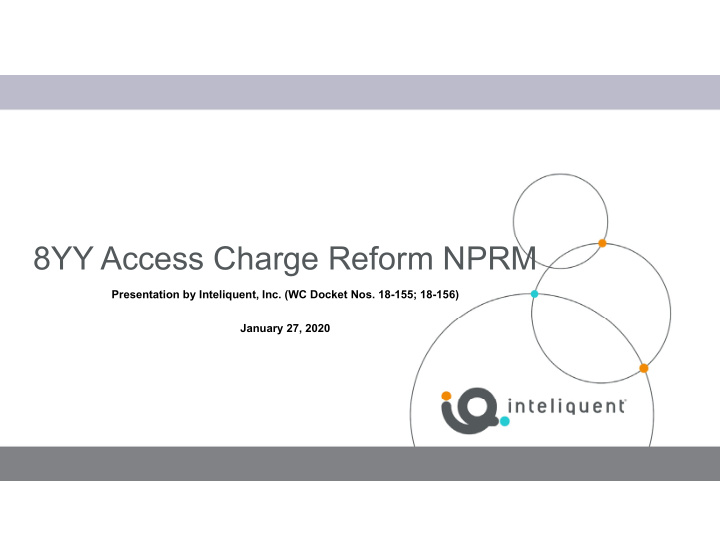



8YY Access Charge Reform NPRM Presentation by Inteliquent, Inc. (WC Docket Nos. 18-155; 18-156) January 27, 2020
Relationship of Recent FCC Actions to 8YY Access Charges Access Arbitrage Order established cost-shifting principle for “free” traffic • Cost-shifting principle • Party stimulating allegedly “free” calls should bear terminating access charges • 8XX service likewise is a "free" number assigned to an enterprise or end-user account, and provision of a "toll-free” number “stimulates” calls • Initial impact of new rules, from Inteliquent’s observation of traffic flows: • No reduction in MOU, but traffic is shifting from multiple rural CLECs to a limited number of rural CLECs and IPES providers • Rural CLECs previously identified as access stimulators and still receiving traffic appear to be claiming they are outside the scope of access stimulation rules • If calls are terminating to entities outside the scope of the rules, the overall cost of delivering access stimulated traffic is currently unchanged • Impact on 8YY • Current FCC policy is consistent: whether 8YY or “free” conferencing calls, party stimulating the call should bear cost of access charges; a change to this paradigm would be inconsistent with the access arbitrage reform • Further data on impact of access arbitrage reforms during 2020 could inform 8YY policymaking, as both proceedings focus on alleged ICC abuses 1
Relationship of Recent FCC Actions to 8YY Access Charges (cont…) In December 2019, the FCC approved a new VoIP Symmetry Declaratory Order. This recently approved Order clarified how a LEC can charge for 8YY access functions performed by it or its VoIP Provider Partner. The impact on originating access charges is expected to be meaningful. • The Declaratory Order essentially impacts originating access charges. Guidance on charges: • If providing facility to premises, end office switching • If not providing facility to premise, tandem rate • The LEC can charge for the functions it or the VoIP Provider Partner actually perform (or the functionally equivalent service) • Impact on 8YY • This new Order has been in effect for less than two months • This change impacts VoIP providers, one of the largest and fastest growing end user segments • Likely will dramatically decrease 8YY access charges for iVoIP calls by ~ 50% • Full scope of cost reduction will become clearer as the year progresses 2
Relationship of Recent FCC Actions to 8YY Access Charges (cont…) The FCC is facilitating and championing STIR/SHAKEN , now against the backdrop of statutory deadlines. Timeline • TRACED Act establishes defined timeline for implementation of STIR/SHAKEN, including key date of June 30, 2021 Impact on 8YY: • STIR/SHAKEN will improve detection and deterrence of spoofed calls, which is a known source of fraudulent toll-free traffic pumping. • By facilitating detection of spoofing, will assist authorities in targeting any remaining toll- free traffic pumping operations for prosecution Conclusion: Access arbitrage rules, the VoIP Symmetry Declaratory Order, and STIR/SHAKEN implementation will have significant impacts on industry and practices in the 8YY space. The FCC should evaluate these impacts carefully before changing 8YY access charge rules. 3
8YY Reform Proposals If FCC nevertheless moves forward with 8YY rule changes in the near-term, it should: Adopt the weighted national average tandem switching rate of $0.0017 , exclusive of 1 nonrecurring and recurring interconnection charges. Adopt national rate for 8YY originating end office charges. In the event FCC lowers rate below 2 national average, any reduction should occur in a transition of at least four years . The final rate should not be lower than the benchmarked tandem rate. Cap database query charges at the national weighted average and limit the number of dip 3 charges to one per call. • Database query charges should be set at the national weighted average rate of $0.004248 per query , as calculated by Inteliquent and referenced in the 8YY FNPRM . • Any lower rate should be phased in during a transition of at least four years. 4
Q& A 6
Recommend
More recommend